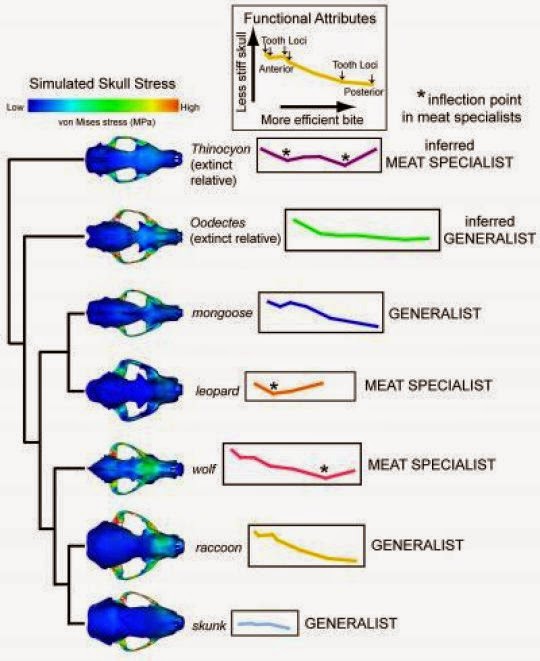
When paleontologists put together a life history for a long-extinct animal, they try to understand its diet by looking at modern animals with similar skull shapes and tooth patterns. But this practice is far from foolproof. New modeling and tests based on living species conducted by scientists at the American Museum of Natural History show that the link between animal diets and skull biomechanics is complex, with a stronger influence from ancestry than previously thought.
“Traditionally, when we looked at a fossilized skull with pointy piercing teeth and sharp slicing blades, we assumed that it was primarily a meat eater, but that simplistic line of thinking doesn’t always hold true,” said John J. Flynn, the Museum’s Frick Curator of Fossil Mammals and a co-author on the new work published today in the journal PLOS ONE. “We’ve found that diet can be linked to a number of factors—skull size, biomechanical attributes, and often, most importantly, the species’ position in the tree of life.”
Dr. Flynn and Z. Jack Tseng, a National Science Foundation and Frick Postdoctoral Fellow in the Museum’s Division of Paleontology, looked at the relationship between skull shape and function of five different modern carnivore species: “hypercarnivores” like wolves and leopards whose diet is more than 70 percent meat and more omnivorous “generalists” such as mongooses, skunks, and raccoons. The initial modeling, which mapped bite force against the stiffness of the animal’s skull, yielded a surprise.
“Animals with the same diets and biomechanical demands, like wolves and leopards—both hypercarnivores—were not linking together,” Dr. Tseng said. “Instead, we saw a strong signal driven mostly by ancestry, where, for example, the leopard and the mongoose bind together because they’re more closely related in an evolutionary context, although they have very different dietary preferences and feeding strategies.”
But once Tseng and Flynn accounted for the strong effects of ancestry and skull size on the models, hypercarnivores and generalists still could be distinguished based on biomechanics, in particular by looking at where along the tooth row the skull is strongest. The skulls of heavy meat eaters tend to be stiff near the front teeth for hunting, and the back teeth for crushing bones and slicing meat. In contrast, generalist skulls get slightly stiffer from the front row of teeth to the back row.
With an improved shape-function computer model in hand, Flynn and Tseng applied the research to a pair of extinct species: Thinocyon velox, a predatory mammal that was part of the now-extinct Creodont group, and Oodectes herpestoides, an early fossil predecessor of modern carnivores. The results suggested that T. velox likely had a unique hypercarnivorous feeding style that emphasized prey capture with its front teeth and powerful slicing and crushing with its back teeth, while O. herpestoides was a generalist.
“Beyond feeding adaptations of extinct species, we also want to decipher how adaptations evolved using reconstructed ancestors of living and fossil forms,” Tseng said. “We are applying similar types of skull shape and biomechanical analyses to reconstructed hypothetical ancestor skulls of Carnivora and their relatives to map out and better understand the long history of feeding adaptation of living top predators.”
Reference:
Zhijie Jack Tseng , John J. Flynn. Are Cranial Biomechanical Simulation Data Linked to Known Diets in Extant Taxa? A Method for Applying Diet-Biomechanics Linkage Models to Infer Feeding Capability of Extinct Species. PLoS One, 2015 DOI: 10.1371/journal.pone.0124020
Note: The above story is based on materials provided by American Museum of Natural History.










